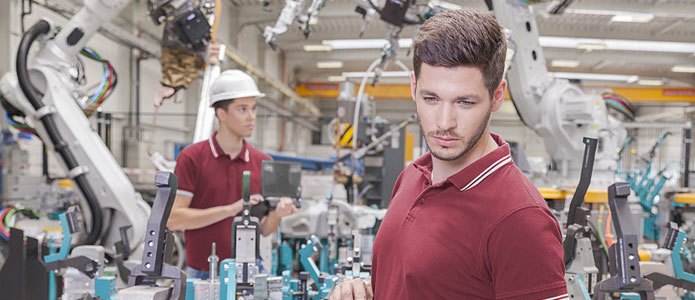They are modernizing industry and changing the ways of the labour market: robots are being increasingly used in companies. That makes companies more efficient, and could give employees more free space.
In the factory, metal trolleys move back and forth between stacker racks and six assembly islands, halt before individual workers, then drive to their next goal. In the southern German town of Graben-Neudorf, SEW-Eurodrive produces gear motors – among other things, for escalators and cranes. Mobile robots help the workers. The technological helpers are specialized in logistics, assembly or mounting machines: cyber-physical “logistics assistants” bring supplies at the right time and speed away the finished workpieces. On a chip, “assembly assistants” transfer all the data of the customer order to workers, drive themselves to the next assembly point and display on a tablet the required tasks. Since this radical modernization, the factory mounts more gear mechanisms than before and in half the time; productivity has increased by 30 per cent. The number of workers, however, has remained the same, although the workload has increased: robots can take some of the work off people’s hands.
Everything is networked
In Graben-Neudorf many of the elements of the production system of the future, what is called “Industry 4.0”, have already been realized. It digitalizes and networks the entire value-chain; people and robots work closely together. At present, it exists at only a few locations. Although Germany has the third-highest density of robots in the world, following South Korea and Japan, the robots still weld, paint, glue or pack mainly behind bars, separated from their human colleagues. New robots, which can work together safely with human beings, must be developed individually for each application, which currently makes their use still very expensive. But that could change. “The human-robot collaboration will gain in importance in the coming years. It will open up great potential for companies, for which the use of robots has so far not made sense”, says Stefan Sagert, robotics expert at the German Engineering Federation (Verband Deutscher Maschinen- und Anlagenbau / VDMA).
Robots are becoming more and more human
In numerous projects, German universities and companies are developing and testing new technologies, often working together. Recently, the large-scale project “Arena 2036” for the development of the “automobile factory of the future” was started under the direction of the University of Stuttgart and with the participation of, among others, Daimler and Bosch. Whereas today assembly line production is still clocked, in future hybrid, electro and fuel cell vehicles will be built alongside each other at adaptable assembly stations that are controlled by mobile robot systems. In the project “Hybr-IT” of the German Research Centre for Artificial Intelligence (Deutsche Forschungszentrum für Künstliche Intelligenz / DFKI), the focus is on human-robot collaboration: the new industrial robot that Volkswagen has been testing for several months can recognize human gestures and behaviour, and swiftly sidestep them while continuing to work. In a few years it may be able to relieve people doing strenuous underframe mounting by, for instance, passing tools on demand and holding components for screwing.
Technological helpers for nursing
Outside industry, there are also numerous possible applications for robots – for example, in nursing. In the project “SeRoDi”, the Fraunhofer Institute for Production Engineering and Automation (Fraunhofer-Institut für Produktionstechnik und Automatisierung / IPA) is working on a care trolley that is capable of autonomous navigation: the nursing staff can call it by smartphone and directly document its use on a monitor. At the Mannheim University Hospital the mobile service robot has already passed its first practical tests.
Job cuts vs. creation of new jobs
Will computers and robots dominate the work world of the future, perhaps even make human workers superfluous? From a purely technical point of view, it would already be possible today to automate many activities not only in production and logistics but also in offices and trade. Worst-case scenarios have been met in recent years with great public resonance after scientists prognosticated the elimination of almost half the jobs in the United States. Economists of the ING-DiBa Bank, which transferred the corresponding study to Germany, saw even 59 per cent of jobs to be threatened. Industrial associations, on the contrary, are spreading optimistic prognoses: the expected increase in productivity would result in the creation of significantly more jobs than would be lost. And in point of act, in recent years many new jobs have been created in precisely the most automated sectors. Katharina Dengler of the Institute for Employment Research (Institut für Arbeitsmarkt- und Berufsforschung / IAB) also sees no reason for panic. She investigated in detail for the first time which activities can be performed by computers and robots. According to her study, 15 per cent of employees subject to social insurance contributions in Germany would be affected by digital change. In the end, however, she reckons a zero-sum game, in which job losses are offset by job gains.
More scope for workers?
It is certain that the future has in store major changes for many jobs. If computers and robots can assume tedious and strenuous routine activities, this could create more free space for workers. But there are also fears that in future people will have less possibility of determining their own work. In this question Katharina Dengler is also rather optimistic: “Whether work becomes more interesting and challenging, or more monotonous and unsophisticated, is a question of design and organization. Our results, however, indicate that demands and requirements will increase.”

Comments
Comment